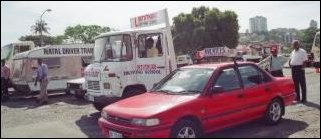Driving Schools: In Need of Facilities
In Durban, many operate behind the central fire station on the grounds of the abandoned bus rank and outside Curries Fountain, the once famous sports venue. Here heavy trucks and cars jostle for space as learners are trained. The only "facilities" on site are two caravans, which act as offices, rest rooms and shelters from the wind, rain and the searing noon day heat. Those who don’t have caravans can only seek refuge in their vehicles when the elements turn nasty. One of the few driving school bodies in KwaZulu-Natal is the Umbumbano Driving School Owners’ Association. Only recently formed, it has 12 members. Mr Harry Bahadui, its treasurer, maintains that driving schools have an important role to play in road safety education. He stresses that all who teach driving have to hold an instructor’s "permit", which they obtain after passing a written and practical test. Their vehicles have dual controls (clutch and brake which the instructor can operate independently of the learner) that enable them to act quickly in the event of a person making a dangerous mistake while learning to drive. "Most of us have been instructors for many years. We are able to quickly assess the weak areas of a learner driver and correct them. We are conscious of the need to have responsible drivers and we do our best to train them to be just this. As trained instructors, we do not have bad driving habits,’ said Mr Bahadui. "We tell our learners that they need to be constantly alert while driving. We stress the need for them to develop a sharp sense of anticipating developments and of reacting appropriately. This skill, of course, comes only with time. We also tell them about the dangers of driver fatigue and of the need to take rest breaks on journeys." According to Mr Bahadui trainees on the average receive between 25 and 30 hours of tuition before they attempt a licence test. Mr Noel Pillay, a driving school owner, says they also make every effort to expose trainees to both peak and off-peak driving conditions by taking people on training drives at different hours of the day. "We try to make the training as real as possible to what they will encounter on the road once they obtain their driving licence," says Mr Pillay.
|
 DRIVING schools in KwaZulu-Natal do not operate as a unified group.
Many function independently, and if they do have links, they are mainly loose
with the owners of schools in the townships or suburbs in which they operate.
But what almost every driving school is desperately in need of is properly
developed areas where they can conduct their lessons and have decent facilities
for staffers.
DRIVING schools in KwaZulu-Natal do not operate as a unified group.
Many function independently, and if they do have links, they are mainly loose
with the owners of schools in the townships or suburbs in which they operate.
But what almost every driving school is desperately in need of is properly
developed areas where they can conduct their lessons and have decent facilities
for staffers.